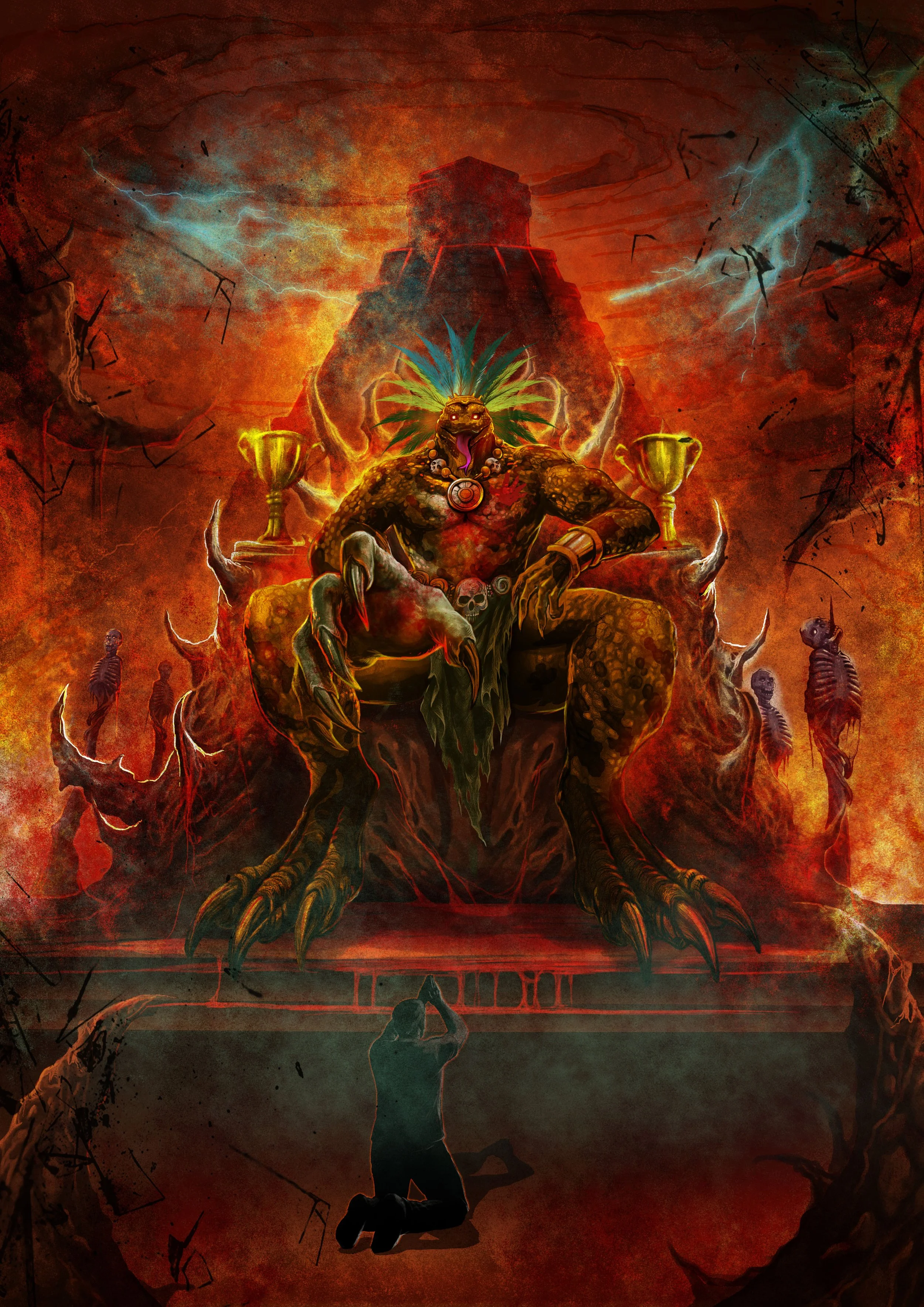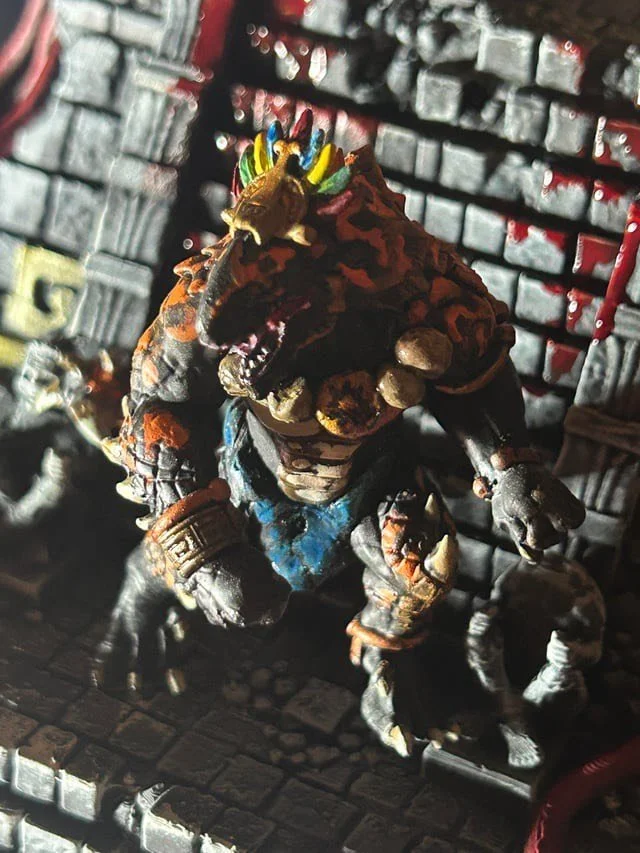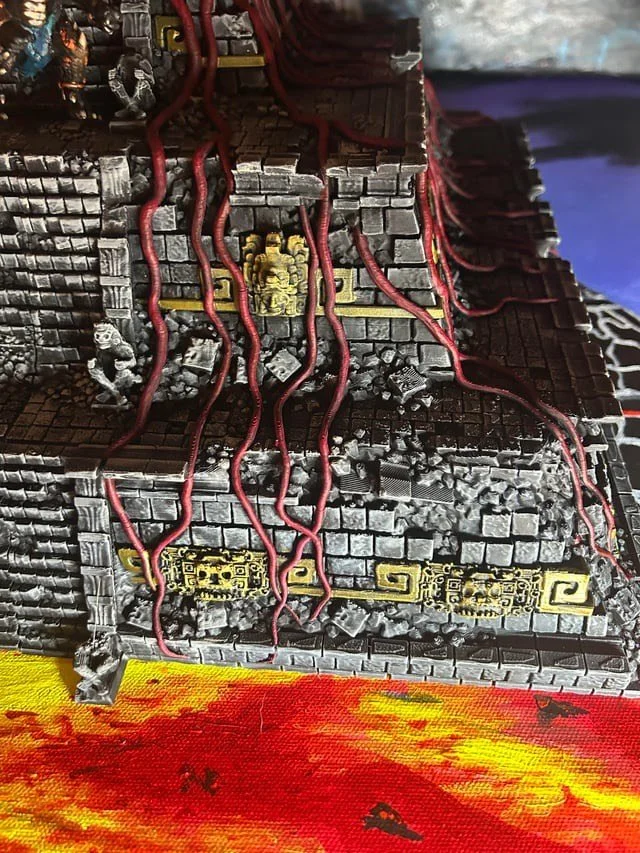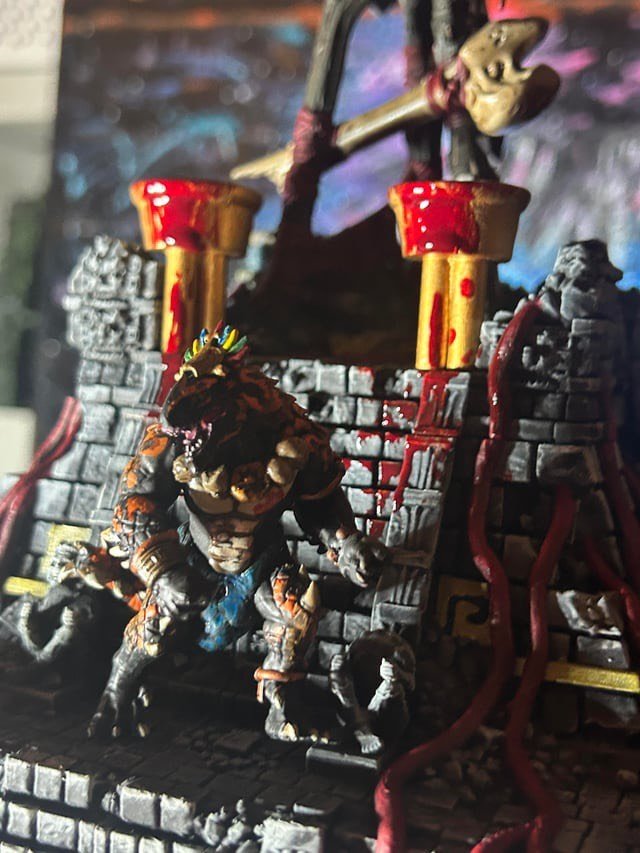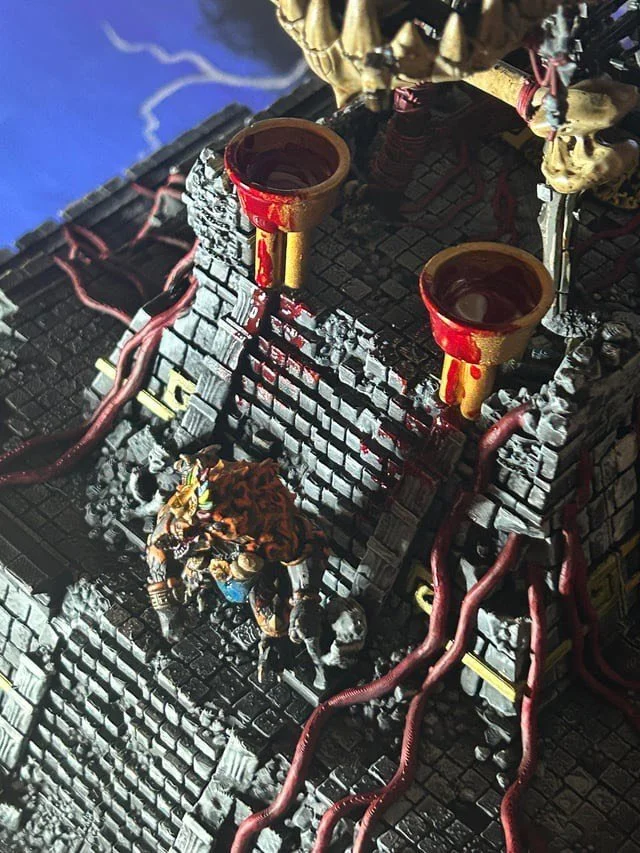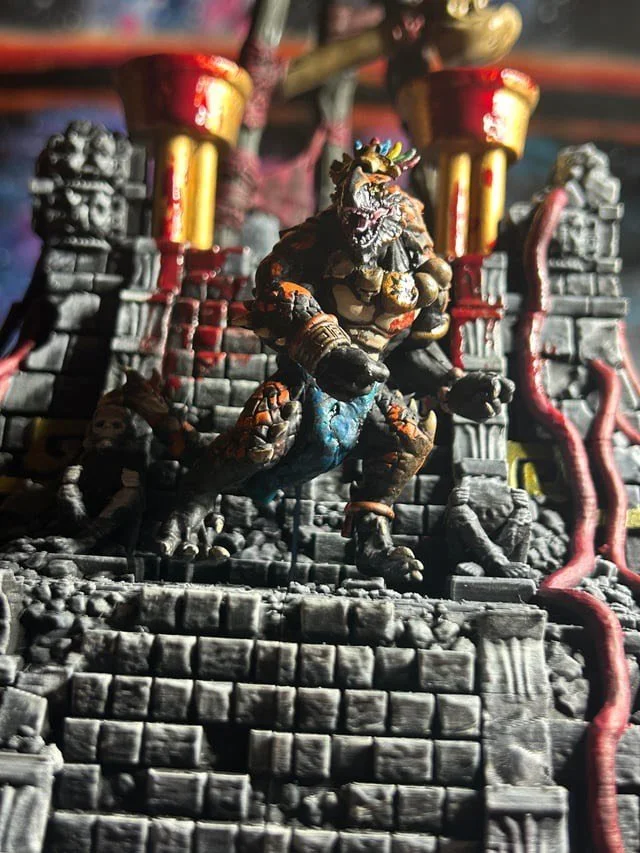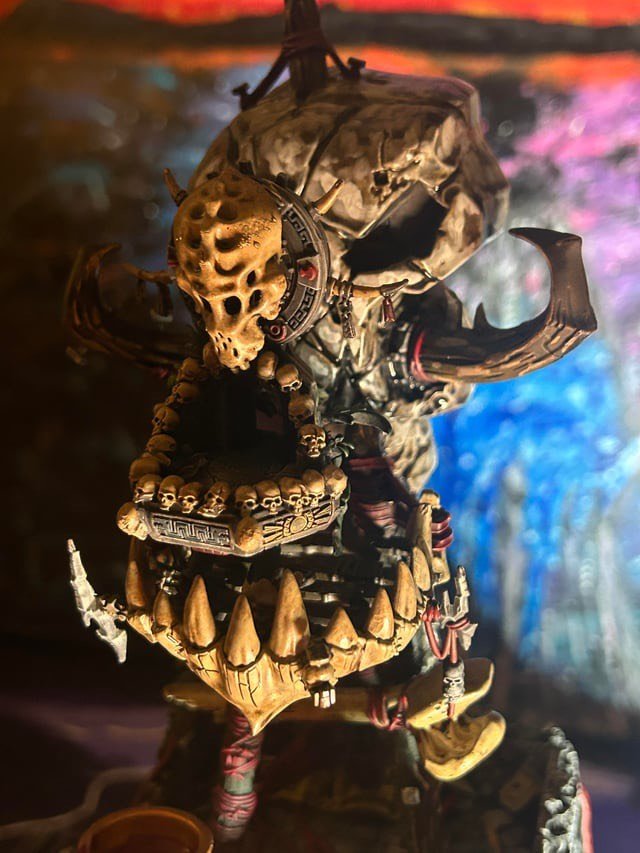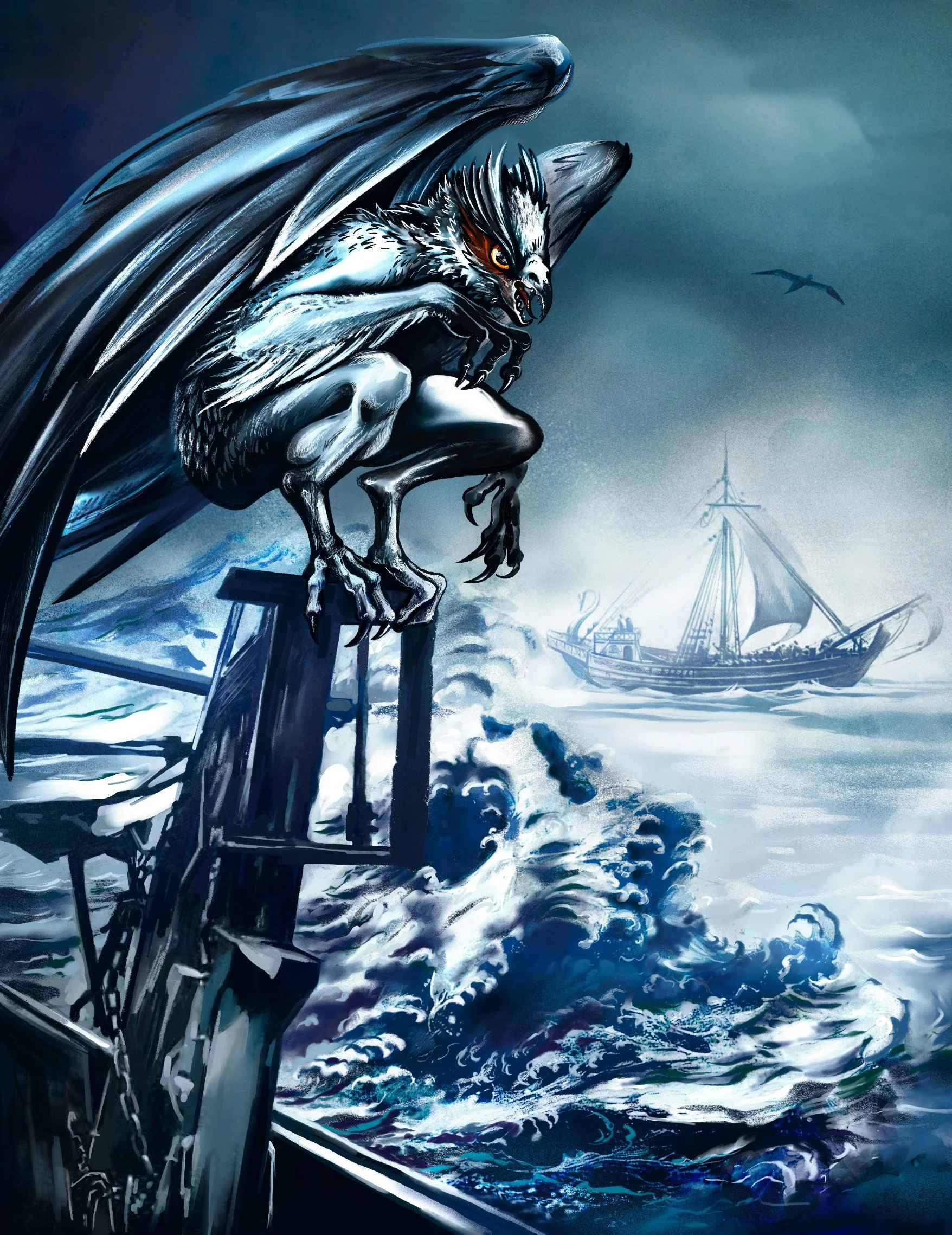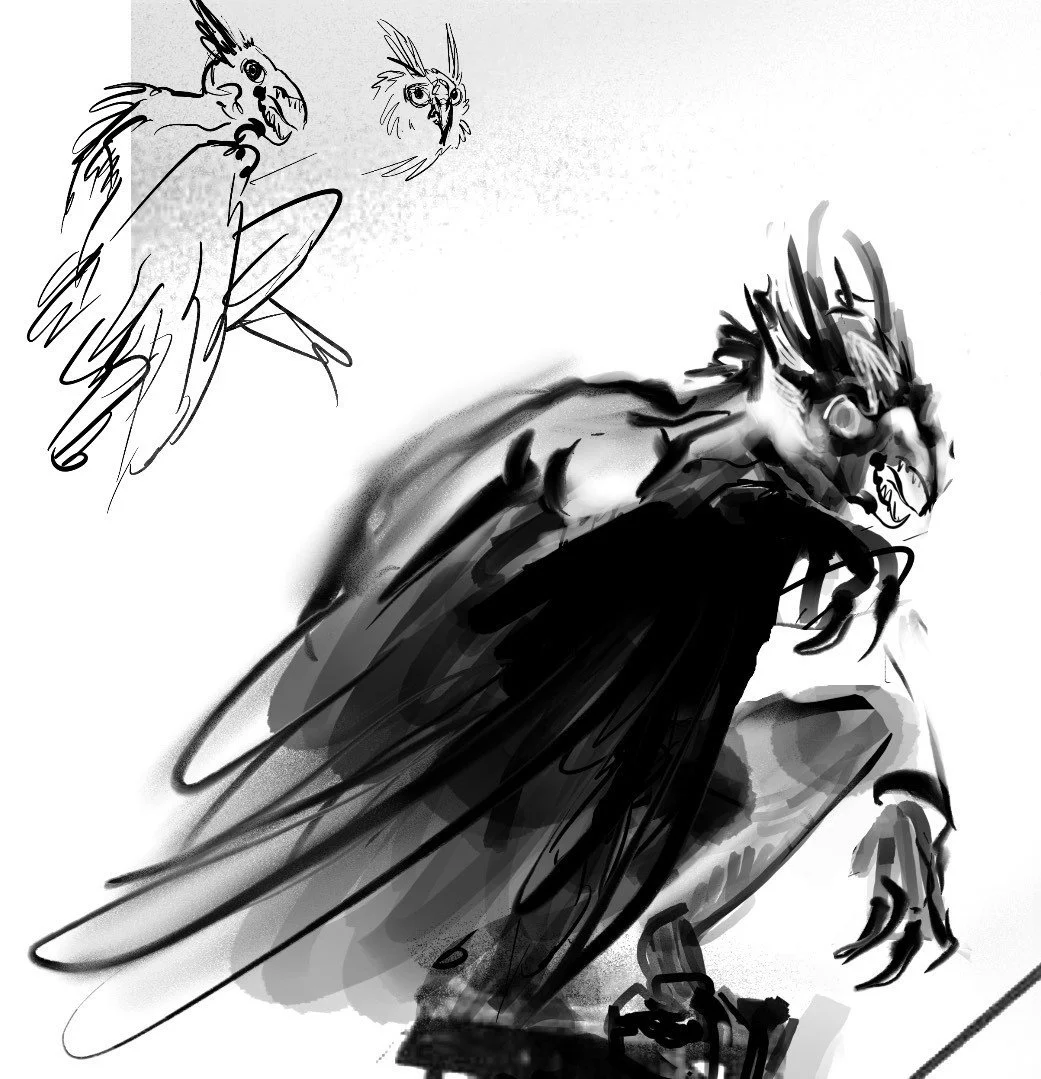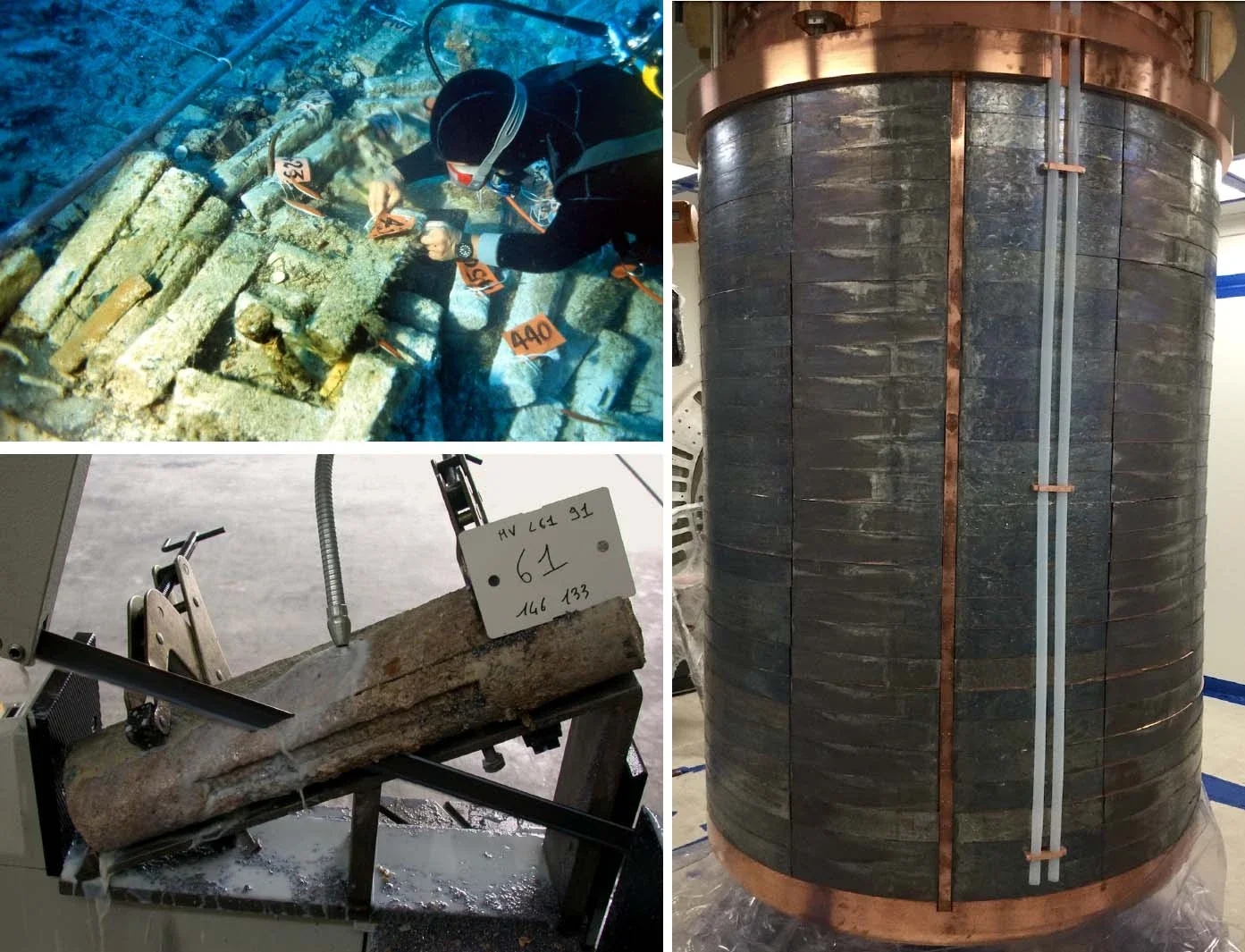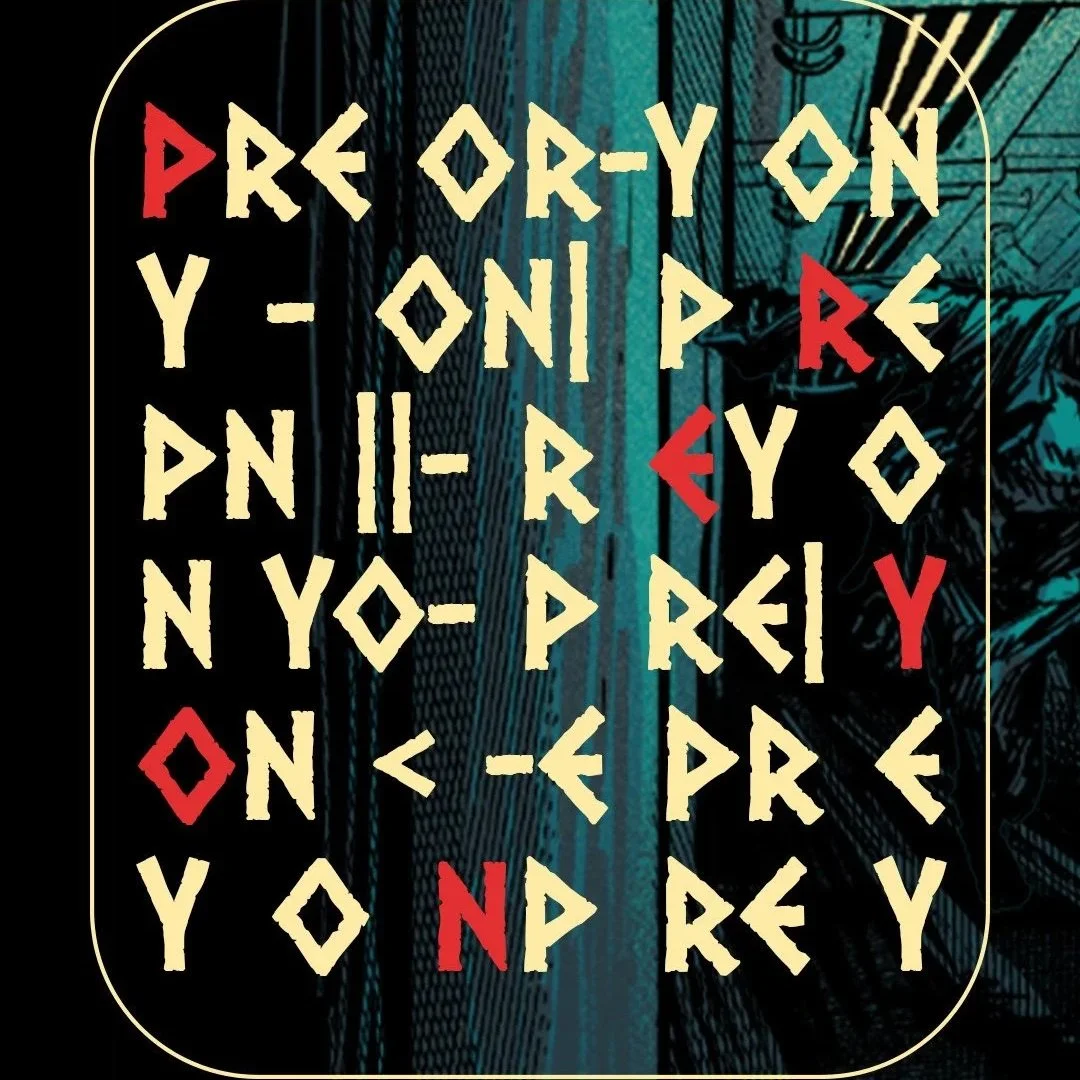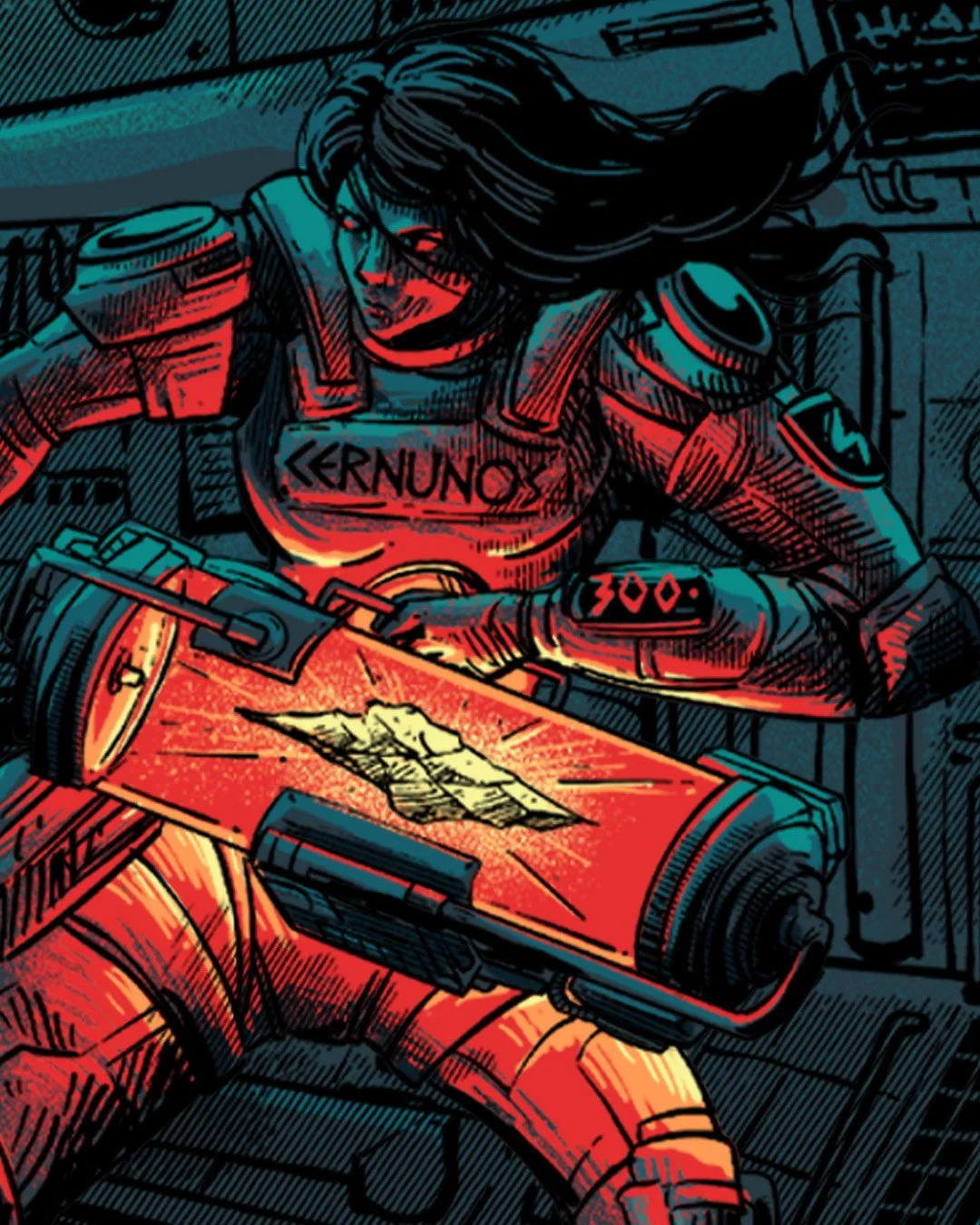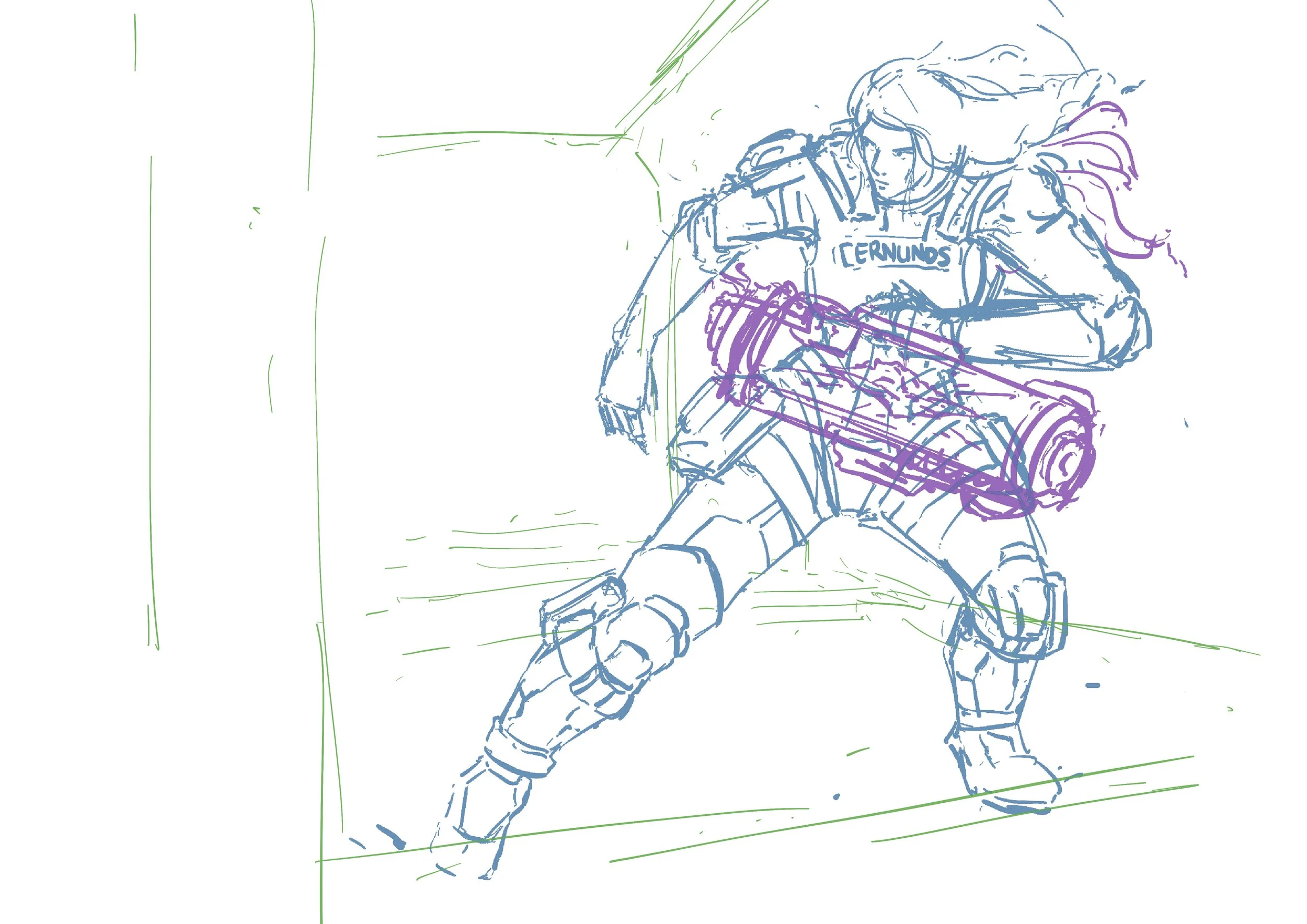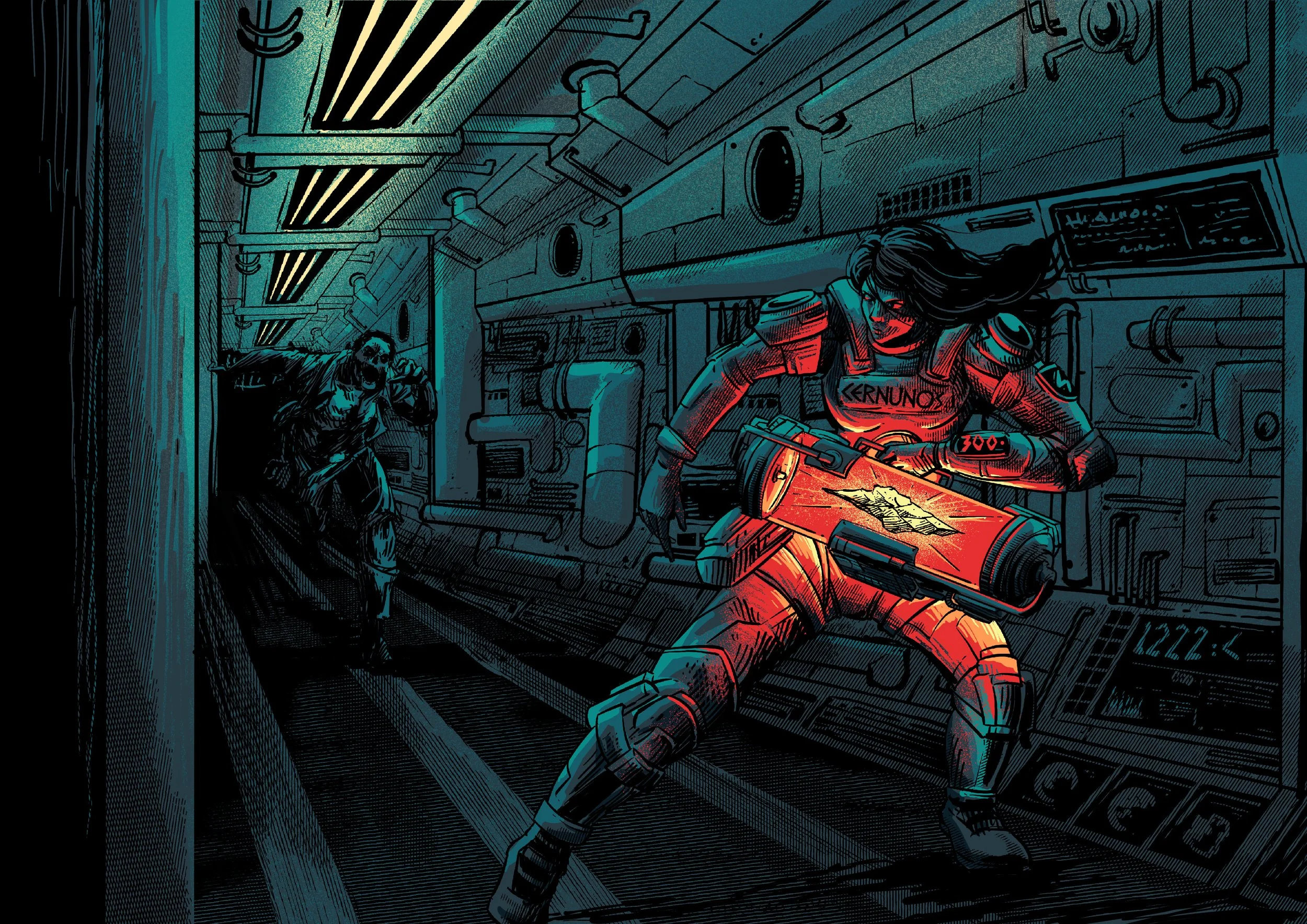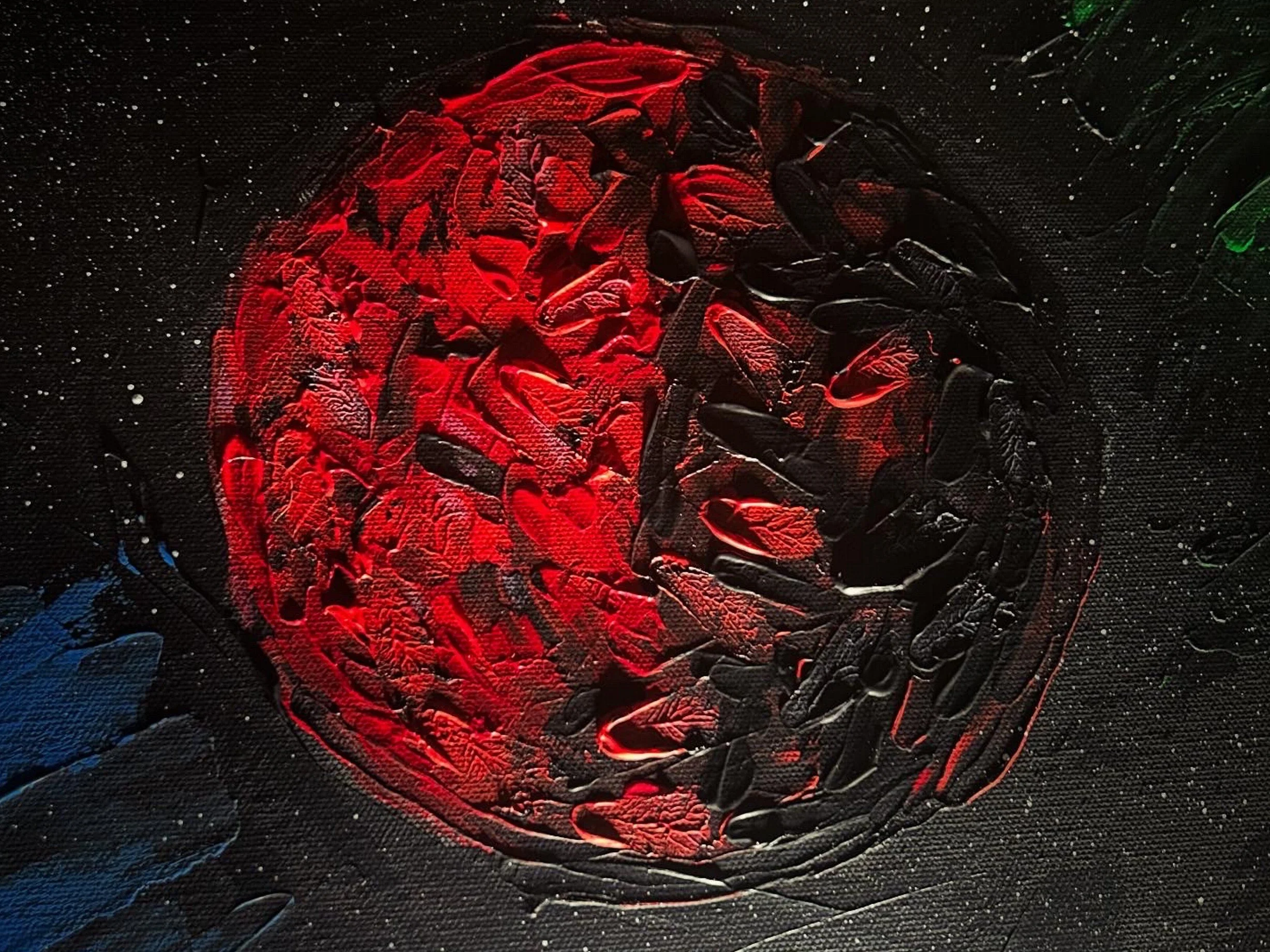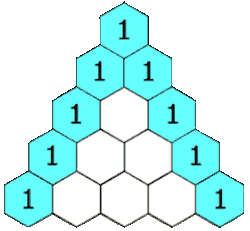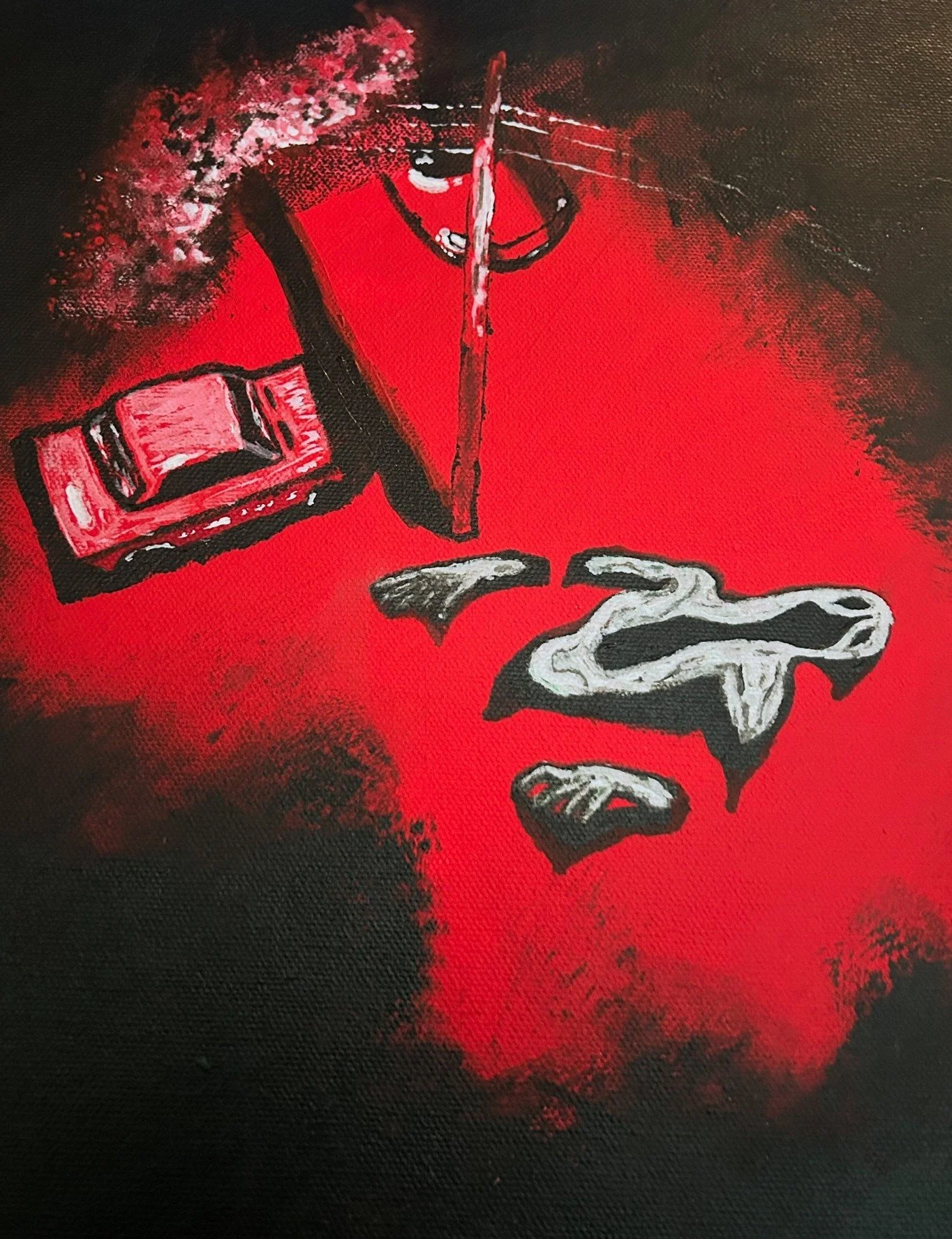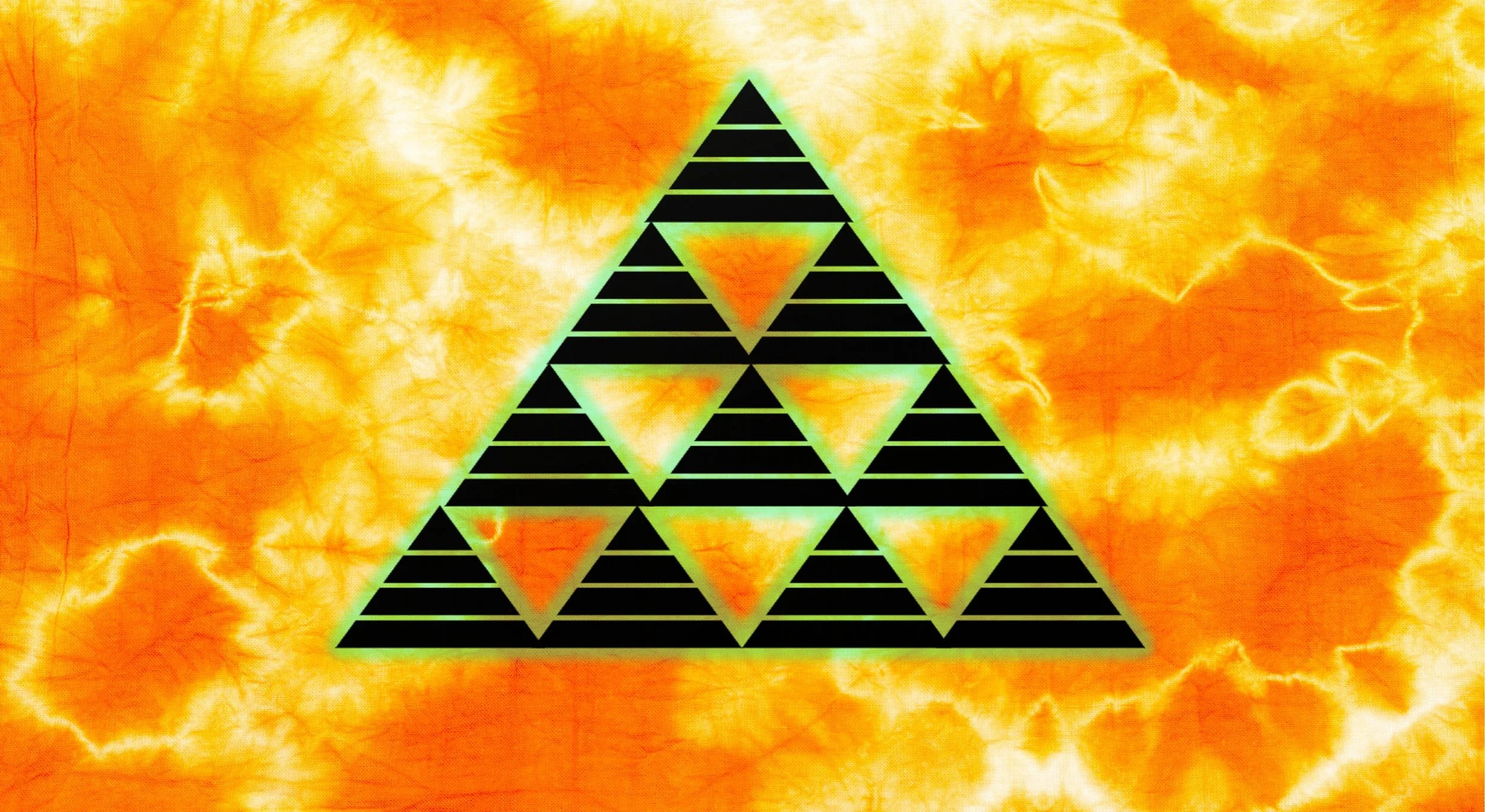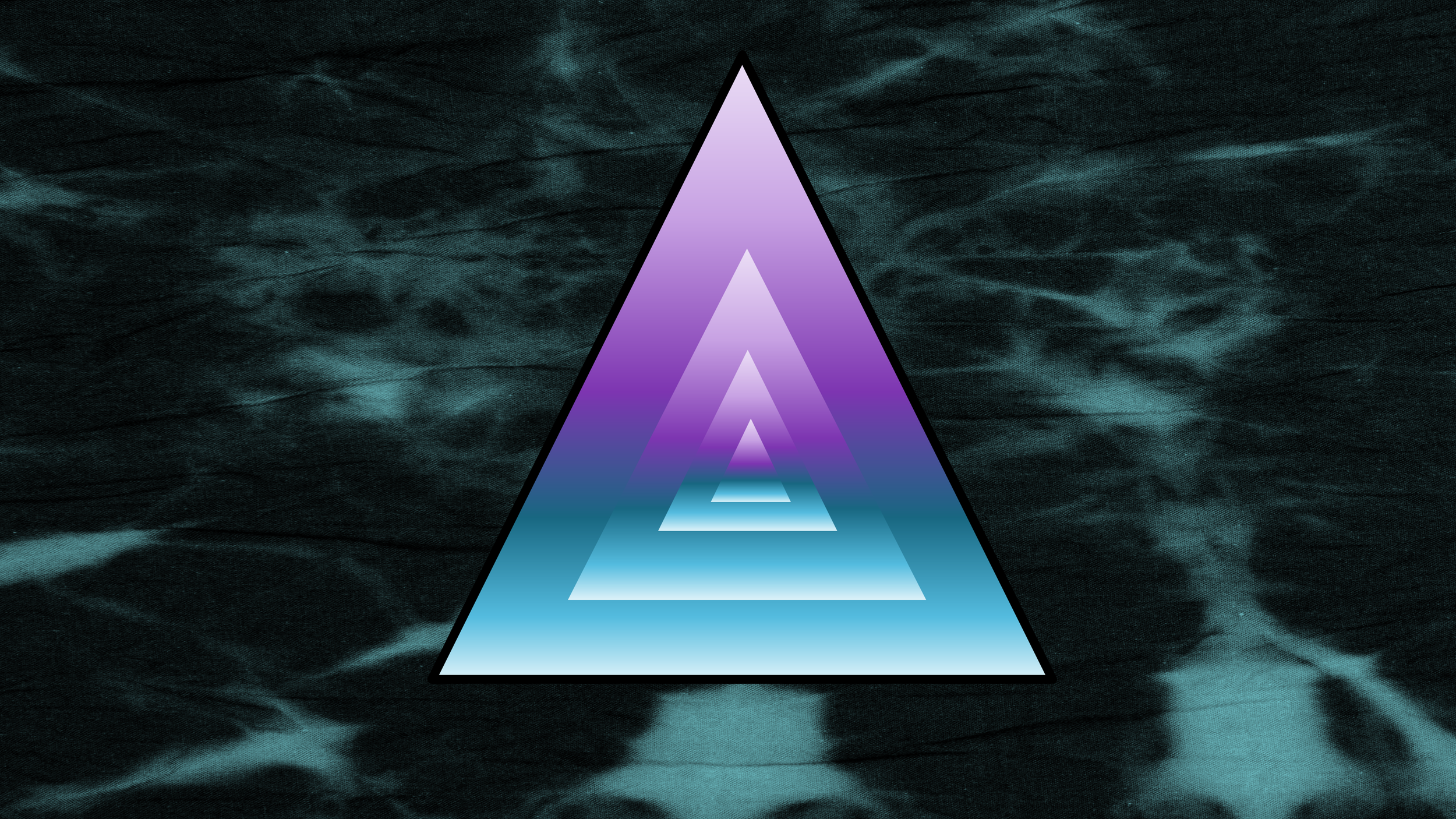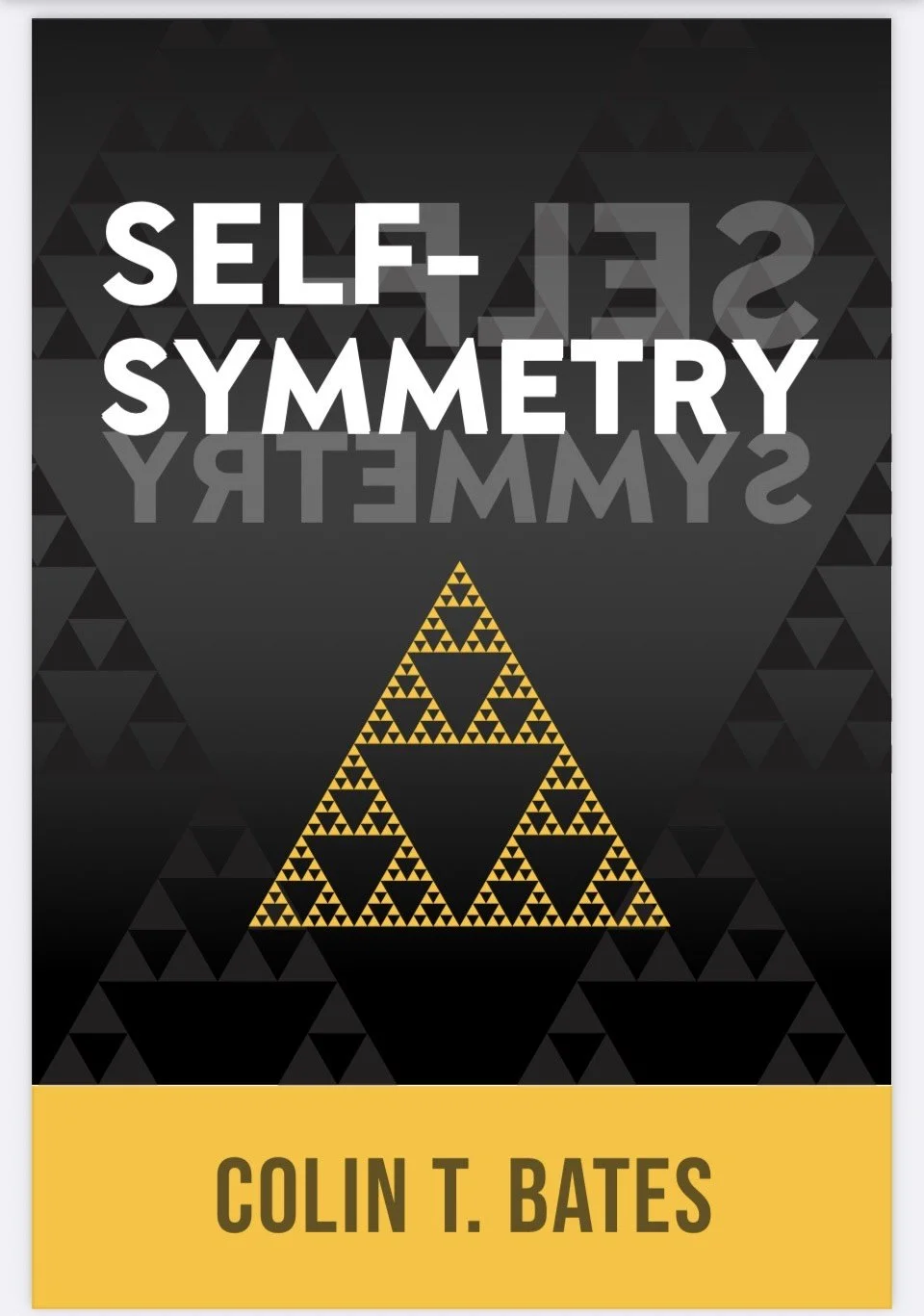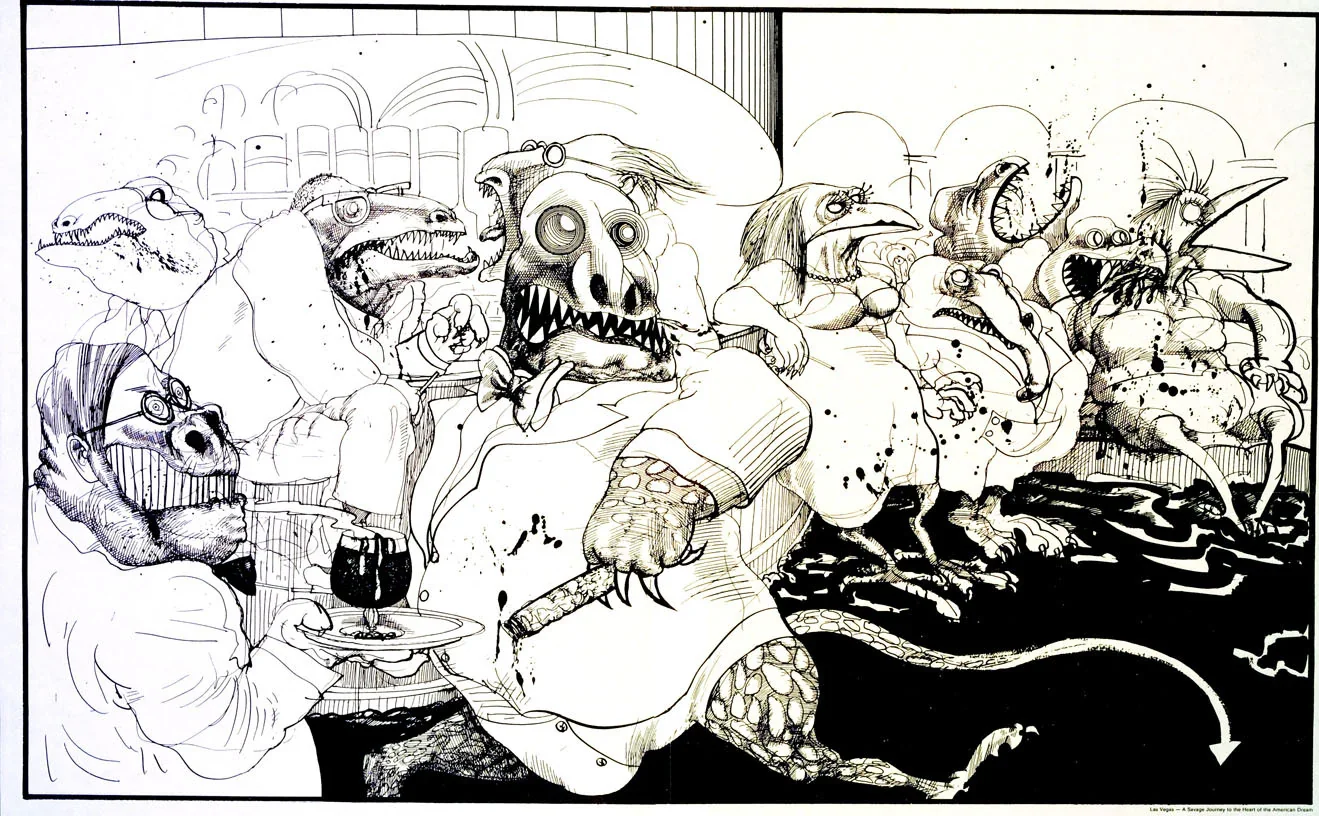
Spoiler Warning for the Horror Anthology Series
The following is a behind-the-scenes look at each of my horror short stories from my anthology series. I aim to provide a fun and deeper dive into what went into creating the works. Read or listen to the stories first, then come back to learn more about the process and inspirations behind your favorite story.
Only proceed to the following section below if you have already experienced The Trophy.

Urochok concept art by Phitoe Art (@wahyukriting)
It all started with blood. For my first story, I knew I wanted to explore the concept of a reptilian blood god. One idea I found fascinating is a now-debunked but once-popular model for the evolution of the vertebrate brain known as the triune brain. Proposed by American physician and neuroscientist Paul D. Maclean in the 1960s, the hypothesis claimed that three independently conscious regions of the brain were sequentially added during the course of evolution. The triune brain consisted of the reptilian complex (in charge of primal instincts), the paleomammalian complex (regulating emotions), and the neomammalian complex (responsible for rational or objective thoughts). Starting in the 1970s, the model was already subject to much criticism and is now regarded as fiction. However, the hypothesis gained much notoriety due to its inclusion in Carl Sagan's Pulitzer Prize-winning 1977 book The Dragons of Eden. Although flawed, I was enraptured by the concept of an aggressive, bloodthirsty reptile living inside our heads. I knew the idea would be fun to explore in a horror short story.
Additionally, the tabletop war game Warhammer 40K and its fantasy companion game Warhammer: Age of Sigmar lore (Khorn and the Seraphon) inspired the creation of Urochok. The songs "Blood for the Blood God" by Death Valley Knights, "Blood for the Blood God" by Gunship and HEALTH, and "Gats" by Susumu Hirasawa were on repeat during my brainstorming process while creating the work.
Enjoy these behind-the-scenes images and incredibly brutal concept art of Urochok by Phitoe Art (@wahyukriting). They were terrific to work with, so give them some support if you enjoy their artistic style. Help human artists, not AI slop. If you have any fun art/sketches/or paintings inspired by the story, please send them my way! I would love to show off more interpretations of the mighty Urochok from others. Additionally, here is my little creation of Urochok with minatures I built and painted. Enjoy!


CTE: Chronic Traumatic Encephalopathy
Although Mickey's tragic tale is fiction, the condition the character struggles with is not. CTE is a degenerative brain disease caused by repeated head injuries, leading to symptoms like memory loss, aggression, depression, confusion, mood swings, anxiety, paranoia, increased impulsivity, and difficulties with speech or balance. The condition is characterized by the buildup of abnormal Tau proteins in the brain. I was shocked in my research to learn that currently, it can only be definitely diagnosed through a post-mortem dissection of the victim's brain. I believe better detection methods should be developed to help those affected manage and treat the symptoms before they lead to deadly consequences.
In 2025, a meta-study by Qi et al. was published, aiming to examine the prevalence of CTE among various athletes. Their results found that 53.7% of contact sport athletes suffered from some form of the condition, with higher rates in elite athletes (72.8%) compared to amateur athletes (44.1%). Although rare, late-stage CTE can appear in younger athletes. In my research, I learned about the heartbreaking suicide of 18-year-old Wyatt Bramwell, who took his own life in 2019 after he shot himself in the heart. One of his wishes in his suicide video was for his brain to be donated to medical science for research. Researchers found that he was the first case of stage 2 CTE to be diagnosed in a high school football player.
CTE can also be deadly for others. In 2007, over a three-day period, Canadian professional wrestler Chris Benoit murdered his wife and seven-year-old son before hanging himself. There are many more tragic cases I am unable to highlight in this brief article. In recent news, in July of 2025, Shane Tamura opened fire in the New York headquarters for the NFL, killing four, before taking his own life. Medical examiners confirmed he also showed unambiguous diagnostic evidence of having CTE. I hope that medical professionals will develop better detection methods to prevent such horrific incidents from occurring in the future.
The Trophy: Aftermath
10x8 Acrylic Canvas
This is how the piece looks now, forever changed by the events of the story. I’ve muted the colors and added red/white/black flow paint on top of the image. What has been done can not be undone. If you are experiencing suicidal thoughts, help is available. You are not alone. Ever.
Speak with someone today
988 Suicide and Crisis Lifeline
Languages: English, Spanish
Hours: Available 24 hours

Phillip Mainländer
Quotes:
“God has died and His death was the life of the world.” Philosophie der Erlösung.
“Life is hell, and the sweet still night of absolute death is the annihilation of hell.” Philosophie der Erlösung.
“The kingdom of heaven after death, nirvana and absolute nothingness are one and the same.” Philosophie der Erlösung.
Philipp Mainländer and the Philosophy Within The Trophy
In our current age of algorithmically enhanced instant gratification and our seemingly post-truth society, I feel as if we have collectively lost many aspects of human nature that help us connect with others. Social media and short-form video platforms like YouTube and TikTok continually rely on maintaining our attention at the cost of authentic human connection. Political divides continue to grow, further exacerbated by the internet echo chambers in which people often find themselves trapped.
I wanted to create something that was not only an interesting piece of horror fiction, but also explores the ideas and writings of various philosophers to help ground the stories in more profound existential questions. In essence, I want to challenge the reader to confront suffering as it relates to the human condition, rather than run from it as most forms of social media insist we do, and reveal the importance of empathy to our own survival. My passion for philosophical ideals stems from my own personal struggles.
In 2016, I was clinically diagnosed with major depressive disorder after my second attempt on my life. The exploration of philosophy has aided in managing my depression. It was only when I was able to confront my condition that I was able to understand it better. For me, the study of philosophy has significantly aided my personal growth. I hope that by infusing my work with some more profound questions or ideals from some of history's greatest minds, it will add something more meaningful to the work than the contemporary, fast-paced internet media we are often inundated with, especially in the age of AI-saturated content slop farms.
The work of German poet and philosopher Philipp Mainländer caught my attention in 2024. I found many of his writings to be hauntingly beautiful, and many of his sentiments echoed with my own self-destructive thoughts, which I attribute to my depression. Tragically, Mainländer would take his own life at only 35 years old. He is known for creating a highly radical form of pessimism, in which he viewed life as having a net negative value, and that the state of "not being" is preferable to being. To me, this sounded similar to the thoughts depression can create. Inspired by Mainländer's works, I sought to express similar views, but infusing them with a more scientific basis, as opposed to Mainländer's more metaphysical ideas on existence.
Davis mountain range photo by Jeff Lynch

The Setting: The Fictional Town of Morrow
There is something magical and haunting about the desert—a place of extremes. As a child, my father's obsession with amateur astronomy would take me on many adventures in search of clear and true Class 1 Bortle Scale dark-sky sites for his astrophotography. In 1997, I had a formative memory from when my father took me to photograph the Milky Way, along with the spectacular sight of Comet Hale-Bopp high overhead. Pictures don't do it justice. It was an incredible sight, I will remember until my dying breath. I still can't get over the fact that the atoms that make up our bodies were forged in the hearts of dying stars.
“We are made of star stuff.” -Carl Sagan
Although Morrow is fictional, in my mind, it is an amalgamation of three real West Texas towns I often visited in my youth: Balmorhea (where the inspiration for the spring came from), Fort Davis (which influenced the story's astronomy and geology aspects), and Marfa (which the fictional town might look the most similar to). Check out this ridiculous picture of me in front of the infamous "Jack-assic" park outside of Marfa. That rubber band gun killed many unfortunate, slow members of the Drosophila genus who came across this wannabe space cowboy's path.
Comet Hale-Bopp. Image Credit: ESO/E. Slawik
The Life Waters
30x40 Acrylic canvas
Conquest of Mexico by Cortés, oil on canvas
History by the Conqueror
Throughout the story, you will find references to various moments from the Spanish Conquest of the Aztec Empire, which took place between 1519 and 1521. The Spanish Empire (and its indigenous allies) was led by the conquistador Hernán Cortés, who led a bloody campaign and also introduced smallpox, which in 1520 killed an estimated 5-8 million people and brought about the end of the nearly 200-year-old Aztec Empire. It is estimated that the conquest resulted in 10,500,000 deaths (Borah/Cook 1989: "El pasado de México: aspectos sociodemográficos" 218-219). To justify their conquest, the Spanish later spread the myth that Cortés was the god Quetzalcoatl. There were no contemporary Aztec records that support this claim. The conquerors, unfortunately, write history. A subtheme I wanted to explore in the work is the lasting trauma of colonialism.
I challenge the reader to study the history on their own and try to find all the references within the story.
That’s it for The Trophy. I hope you have enjoyed this little peek behind the creative curtain.
Now read or listen to Mortifer, then come back to learn what went into making that story, or my others.
Thanks for reading! Stay awesome!
Sincerely,
-CTB

Spoiler Warning For Mortifer
Only proceed to the following section below if you have already experienced Mortifer

From the very beginning, I knew I wanted to do a vampire-like story, but without a vampire. So, with this idea in mind, I did what I always do: I started doing research.
Eventually, I learned about the ancient Greek author Antoninus Liberalis's Metamorphoses, which tells the tale of Polyphonte, who, along with her sons, was transformed into birds as a punishment for cannibalism. However, in Greek myth, the ill-omened Strix was never permitted to harm humans. Not good for a horror story; however, later in Italy, the myth expanded into bloodthirsty monsters in bird form. The first Latin mention of a Strix comes from Titus Maccius Plautus' comedy Pseudolus, from 191 BCE, where a poor cook's food causes the characters to metaphorize into Striges, or "vampyre owls," which devour intestinal organs. There was my creature! The Romans saw them more as vampire owls that ate human organs and flesh. Next, I needed to dive into Roman history to find a fun moment to set the story. Little did I know that science would play a role in my selection.
Check out this amazing concept art for what Decimus might look like, transformed, and the Bellona from Anna Hryshchenko. If you have art you made related to this story you would like to share, send it my way, and I will show it off here!
Monster Profile: The Strix!
As always, here are some tunes I was obsessed with while writing the story.
Music to become a Strix:
Bite Marks by League of Legends Music, TEYA
I Don’t Wanna Be Me and Love You To Death by Type O Negative
Torment by Double Echo
If You Were Here by Ash Code
Behelit by Slaughter to Prevail
Cantate, RV 684 “Cessate, omai cessate”: II. Ah ch’infelice sempre by Antonio Vivaldi, performed by Andreas Scholl, Chiara Banchini, and the Ensemble 415


The Roman Merchant Shipwreck off Mal di Ventre and Particle Physics
Research can take you to interesting places. Somehow, I came across a science paper about physicists searching for evidence of neutrinoless double beta (0νββ) decay. If discovered, this type of theoretical radioactive decay would prove the nature of neutrino particles. The detector they were using needed a lead shield to prevent interference from external beta particles. Commercial lead often contains radioactive particles (created by the decay of lead-210), which can cause noise as they decay and ruin the experiment. So, the scientists used ancient lead discovered from a shipwreck found in the 1980s off the coast of the island of Mal Di Ventre, which contained 102 Roman lead ingots!
The half-life of lead-210 is 22 years. So, this 2000-year-old lead has lost most of its radioactive elements and is much better suited for the highly sensitive experiments they wanted to perform. It was so interesting to learn about when archaeology and physics come together to do science!
I did a deep dive into the archeology papers and decided I wanted to tell the untold fictional story of how this ship full of Roman lead ingots ended up at the bottom of the sea. It is believed the ship sank around 75-25 BCE, based on coins found in the wreckage. There are even easter eggs from the shipwreck's archaeological papers included in the story (the anchor with a dolphin carving, clay amphoras, and, of course, the lead ingots themselves).
Enjoy these photographs of the island and the lead ingots as they were discovered and eventually used in the CUORE device. Unfortunately, the physicists did not find evidence of neutrinoless double beta (0νββ) decay. The hunt continues.
Wanna know more? Check out this SciShow video about the shipwreck and its connection to physics. The video is about 30 minutes long.
David Hume and Marcus Aurelius
For Mortifer, two philosophers caught my eye. David Hume (1711-1776) was a Scottish philosopher famous for his empiricism, skepticism, and his writings on causality. Hume argued that people never actually perceive that one event causes another. Instead, he insisted that we only experience one event followed by another, which he called a "constant conjunction" of events. I actually really enjoyed reading one of his papers. He also mentions oysters a lot in his writings. His work influenced the structure of the narrative and that strange opening, which also draws on another inspiration I will mention in the next section. Of course, I had to add a bit of my own scientific spice. Have you figured out what those two distant cold bodies are?
Additionally, Marcus Aurelius (121AD-180AD) and his Stoic philosophy became another significant influence in shaping the narrative. Although he lived after the events of the story, I still felt compelled to include some of his ideas in the work. Some of the core principles of the Stoics included focusing on what you can control, accepting external events, and the four fundamental virtues: courage, justice, wisdom, and temperance.

The Legendary Three
Lastly, I wanted this story to pay homage to three titans of creativity. These legendary three manga artists — Kentaro Miura (Berserk), Hirohiko Araki (Jojo’s Bizarre Adventure), and Hajime Isayama (Attack on Titan) — have each created works that have moved me to tears. Please do yourself a favor: explore their works on your own. You won't regret it. Tragically, Miura passed in 2021.
That’s it for Mortifer! I hope you have enjoyed this behind-the-scenes look! Now, I will be busy working on the next section for Prey On.
-CTB

Spoiler Warning for Prey On
Please only continue to the next section if you have already experienced Prey On.


Enjoy this incredible promotional art for Prey On by Pijar Arif of Rockhopper Id
Help human artists, not AI slop.
If you have artwork from the story, send it my way, and I will add it with your credit as well!

It Came From Outer Space: Prion Zombies?
Often, my creativity begins with the concept of a scientific mechanism I want to explore. From the very beginning, I knew I wanted to do a zombie-in-space kind of survival horror story. However, I wanted to do a different mechanism for the zombie condition that I have not seen explored in other media. Other popular franchises like The Walking Dead use the classic virus as a method for creating the zombie condition, while The Last Of Us uses the concept of a parasitic fungus (Cordyceps). I knew I wanted to try to have my own unique mechanisms that could create zombies. I personally have never seen prions or misfolded infectious proteins cause the condition in any sci-fi media (email me if you know one that does! I would love to read or see it!).
Are prions a good method to spread the zombie condition? Likely not, Creutzfeldt-Jakob disease can take up to 14 months from symptom onset to patient death. However, the slowness of the condition gave me an idea. Was there a way that a prion could replicate a lot faster? I searched the scientific literature and found this interesting paper from 2014, which outlines the idea that when the universe was around 10-17 million years old, it might have been possible for early forms of life to develop in space due to the intrinsic temperature of the entire universe making conditions tolerable for early life chemistry to occur! In 2023, it was discovered that the amino acid tryptophan had been observed in the stellar gas cloud of the young IC 348 star cluster. This evidence may mean that certain amino acids are widespread in protoplanetary disks, protostars, and even interstellar space. The origin of life on Earth is also a very interesting subject. It seems as if as soon as life could arise on the Earth, it did. Perhaps this fact stems from life evolving in the early universe, going dormant and reawakening when it arrives on planets that are habitable for life to continue to progress? We still don't know how life first originated, yet putting all of these scientific ideas together, I felt like it could be possible that pre-life organics might be widespread throughout the cosmos.
So, perhaps my zombie-prion is a super-prion from the dawn of time that can replicate much faster than other known prions because it is designed to misfold and copy any proteins it encounters. A super replicator, if you will. This idea would allow it to exist locked away in a cold, dead asteroid, which is where the idea for the crew being asteroid miners came from. I love exploring fiction ideas and giving them fun, slightly plausible scientific explanations. Do I think there are real killer zombie prions locked away in organic asteroids? Probably not, but it certainly is a fun novel concept to think about!
Cover art for Prey On by me
20x16 acrylic canvas (I later put it through a digital filter to get the little protein ball effect you see on the book cover)
Space Tracks I was jaming to when writing the story:
Leverage by Hannah Parrott
Koyaanisqatsi (Kummerspeck Remix) by Philip Glass and Kummerspeck (link to the original as I couldnt find the remix on YouTube)
I Was Lost Without You by Sam Hulick
The Son of Flynn by Daft Punk
Gigawatt by Zombie Hyperdrive
Intergalactic Highway by Dynatron
Neo-Tokyo by Scandroid, Dance With the Dead
Odyssey by Dance With the Dead
Legend of the Martial Artist by Yoshihisa Hirano
Oblivion by M83
Terraforming by Hans Zimmer
I Am The Doctor by Murray Gold

Cernunnos and the PILLARS
To create my own version of a futuristic mega corporation, I wanted to draw from mythology. Cernunnos was an ancient Celtic deity often associated with wild nature, fertility, the underworld, bi-directionality, and prosperity. The name of the AI assistant the characters use in the story comes from the true archaeology about what we know about this god. In the first century AD, a Roman column was erected to honor Jupiter by a guild of boatmen in modern-day Paris. Known as the "Pillar of the Boatmen," the pillar contains one of the only undisputed instances of the name "Cernunnos" along with a visual representation, along with other Roman and Celtic gods. The Pillar was discovered in 1711 under Notre-Dame de Paris. While a large number of archaeological discoveries depict a similar figure of an aged male figure who sits cross-legged, has antlers on his head, and is associated with ram-headed serpents and wild animals, this is the only artifact with an inscription of his supposed name, although there is still some scholarly debate about this.
The Ordovician Mass Extinction: a Gamma Ray Burst Event?
Did you know that Earth has experienced at least five major mass extinction events in its history? One of them became an inspiration for the story! Occurring roughly 445 million years ago, the Late Ordovician mass extinction (LOME) event eliminated 49-60% of all known marine genera and is thought to have wiped out nearly 85% of marine species. Evidence from the fossil record suggests this mass extinction event occurred in two, maybe three pulses. The second pulse has been explained as a glaciation event. However, a minority hypothesis suggests that the first pulse may have been caused by a gamma-ray burst originating from a hypernova in a nearby arm of the Milky Way Galaxy, some 6,000 light-years away.
Proposed by Philip Ball, Adrian Lewis Melott, and Brian C. Thomas, a roughly 10-second burst of intense gamma rays would have stripped Earth's atmosphere of half its ozone and exposed surface-dwelling organisms to intense UV radiation. The hypothesis goes on to claim that 20-60% of all phytoplankton would have been killed as a result of the event. It would also explain the glaciation event that would follow, as high-energy gamma rays would dissociate ozone, and reactive oxygen atoms would react with nitrogen to form nitrogen dioxide, a dark colored aerosol which might cool the planet. There is also isotopic evidence of carbon isotopes becoming sequestered during this time.
Although this hypothesis is consistent with some patterns observed at the onset of the extinction event, there is no unambiguous evidence for a nearby gamma-ray burst. Because Ira is a geologist, she would have an understanding of deep geologic history, thus I felt this topic was an interesting way to both convey some of Kant's philosophical views, express the beauty of an ancient and threatened ecosystem (coral reef systems) due to climate change, as well as introducing the reader to a gamma ray burst before one much further away occurs and mess up their mining operation in the present of the story.
Giant octocoral as mentioned in the story, photo taken by me off the coast of Belize in Spring of 2025

The Horrors of Late-Stage Capitalism and Climate Change
When I was doing my prewriting for this story, two other topics caught my attention. The first was to explore Late-Stage Capitalism, and the second is the looming issue of Climate Change. Let me start by saying I am not an economist; however, I have published and co-published scientific literature on the subject of climate change. The following are my limited ideas about where we might be headed regarding these two issues.
To explore this, let us start by defining what capitalism is. As I understand it, capitalism is an economic system in which individuals and private parties control the means of production, and profits are the key drivers of economic activity. Some key characteristics of this system include competition, private property ownership, self-interest, freedom of choice, and markets that control the pricing of goods and services.
In 1996, the American Stock Market listed roughly 8,000 companies. Since then, the American economy has grown to nearly 25 trillion dollars, and now, in 2025, the Stock Market has only about 4,000 companies listed. What is happening? How can we increase the value with fewer companies? The answer is that about 25% of American businesses are now owned by private equity firms. Competition and market control over prices are being eroded by these private equity entities, which gobble up corporations at an alarming rate. These facts were the inspiration behind the six mega corporations that took over in Prey On.
Additionally, why does it feel as if everything is increasingly becoming a subscription-based model? It is becoming ridiculous how many subscription services there are now. I need Netflix, Microsoft Office, Xbox Game Pass, YouTube Premium, Spotify, and the list keeps growing, seemingly indefinitely. Furthermore, homeownership has been declining, especially among Millennials, with nearly 2 out of 3 people under 40 renting. Meanwhile, the cost-to-income ratio has risen for renters and declined for homeowners, creating one of the largest wealth gaps between owners and renters, reaching nearly 50% in the last decade. These are the signs of a transition to a rent-based economic system. We are now in a battle with billionaires who do not want you to own anything, and instead wish you would rent everything from them. Private ownership is a hallmark of capitalism, yet they seek to make you rent all of the services they offer.
To make matters worse, we are entering the age of digital share-cropping. After the Civil War, sharecropping was a legal arrangement in which a landowner allowed tenants to use the land in return for a share of the crops produced. The rise of industrialism would render share-cropping obsolete, yet it has returned in a more insidious digital way. Content, views, and engagement are the new crop of the digital era. Now, platforms like TikTok, Instagram, or YouTube pay creators pennies for their abstract labor in creating eye-catching videos or posts, in the hope of going viral. At Amazon, I make only 20-70 cents per sale on my digital, physical, or audio stories while Amazon takes a much larger cut. I fear things will only get worse as we shift further from a labor-based to an abstract rent-based economy.
Next, let's discuss AI. AI slop is everywhere. Did you know it can cost over 200 million dollars to train a large language model? Not to mention the increased processing power every time you query that model. Ultimately, I believe these tools are being pushed on us as a method of control. They want to know what we will buy, what new hobbies we might be interested in, and how best they can influence our personal decisions. Digital AI assistance is not your assistance. They exist to understand and manipulate you and your purchasing power. Our reliance on them undermines our self-interest and freedom of choice, which are vital in a capitalist society. These AI tools help their owners, not you. Be careful how you utilize these tools. They are not your digital friend; they are a method to manipulate your choices. At some point soon, they may be spitting out responses that are paid advertisements disguised as genuine advice.
Let's shift gears and discuss briefly that second topic. I often worry about humanity's future. In 1900, the global average parts per million (ppm) concentration of carbon dioxide in the atmosphere was about 295 ppm. In 1950, it rose to about 310 ppm (15ppm in 50 years). By 2000, it was at 370ppm (60ppm in 50 years). In 2015, when I started my PhD program, it was at about 399 ppm (29 ppm in 15 years). When I finished my program in 2021, I watched in horror as it rose to 415 ppm (16ppm in 6 years). In May of 2025, it was recorded at over 430 ppm (15ppm in 4 years). Greenhouse gases like carbon dioxide trap heat in our atmosphere, leading to climate change.
Many scientific models try to estimate the global surface temperature by a specific date, 2100. Current estimates range from 2 to 4 degrees Celsius for conservative models and from 3 to 6 degrees Celsius for models (SSP5-8.5) with high emissions and limited climate action taken. I fear it may be worse than we think. I do not know of any models that estimate further into the future (past 2100), because there is always more error in a projection that far out in time, and thus it is less reliable. Although new models are being called for that go past this date.
My estimate in the story is meant to be scary. It is a clarion call for action. I don't want it to be accurate, although I fear capitalism may ignore the issue and instead focus on expanding new developments in space or on other planets. Resist. Every action we take today will help, even if they are small. The worst thing we can do is rob future generations of this beautiful planet for short-term economic gains. We need systems like Universal Basic Income, we need regulations of AI development, both from an environmental standpoint, as well as the potential for higher-order AIs to snuff us out of existence. Like it or not, the 6th mass extinction event, known as the Holocene extinction, is currently ravaging ecosystems. The contemporary rate of extinction is estimated at 100 to 1,000 times higher than the natural background extinction rate. Remember, 99.9% of all the living things that have existed are extinct. The universe is a brutal place; survival is never guaranteed.
In the face of environmental change, complacency is deadly. The 'business as usual' approach will generate conditions no human has ever faced before. However, it is not a binary. Success and failure are not measured by the actions taken at a specific moment in time. The sooner we act, the less damage is done. Spread the word, vote in your local elections, and use your purchasing power to help support efforts that improve the environment and the climate. Let us move towards a more mutualistic relationship with our environment and take on the role of stewards of the Earth, for all life's sake. Change is inevitable; let's work together for a better future, not a default one.

Sci-fi Writers Tribute:
Arthur C. Clark, Philip K. Dick, and Andy Weir
The first sci-fi book I ever read was Rendezvous with Rama by Arthur C. Clark when I was a boy. I was entranced by the journey of a team trying to understand a derelict alien spacecraft that is waking up as it passes closer to our sun. It was the beginning of a lifelong love for science fiction. Although, genetically engineered space monkeys were a silly idea, and I wish they were utilized more in the story, as I still to this day don't fully understand their inclusion. Regardless, the story had a lasting impact on me and marked the start of my journey into science fiction. In college, I discovered Philip K. Dick and cherished my first read of Do Androids Dream of Electric Sheep, which I contend is much better than the movie adaptation, Blade Runner. In graduate school, I discovered Andy Weir with The Martian and, more recently, with Project Hail Mary. As Prey On is my first true science fiction set in a dystopian future, I wanted to pay tribute to these three incredible sci-fi writers for inspiring my own journey into the creative space.

Spoiler Warning for Self-Symmetry
Only proceed to the following section if you have already experienced Self-Symmetry


Check out the phenomenal work of artist Scuttlekid, who created this promotional poster and sketch for the story.
Help human artists, not AI slop.
If you have artwork from the story, send it my way, and I will feature it!
Monster Profile: The Informational Basilisk
I have recently become interested in learning about how large language models work. Currently, I am interested in learning more about AI takeoff speeds. If you are like me, here are some interesting places to keep learning more: Website and YouTube video.
In 2019, while working on my own research at The Institute for Environmental Genomics, I used a random forest machine learning algorithm to analyze a large dataset to identify correlations among various environmental variables. It was really cool! I was amazed by how the algorithm could investigate so many variables at once. In just six years, the technology behind these more advanced neural networks has put the dinky R-code random-forest machine-learning algorithm I used to shame. How far will technology like this progress? It's difficult to say. From this wild growth of AI models, there is a nested fear: something that might appear that can't be controlled, that might proliferate, outmaneuver us, outsmart us, and maybe even take over. It's a classic fear of humanity vs the machines. Let's hope safety measures are actually being followed. I have always enjoyed a bit of the internet culture of creepy pasta, which are little short horror stories copied and pasted around the internet like urban myths. Thus, I went to work researching and eventually learned about Roko's Basilisk.
The information about that internet post in the story is all true. There was this little weird post in 2010 that got banned on the LessWrong forums. It took a bit of digging to find and read the original post. Caleb's line about "post-Calvinism bullshit" is even a little easter egg for a real comment someone made on the actual post. Go searching for the post on your own...if you dare to look into the eyes of the Basilisk. I found the idea very interesting and saw its potential to worm its way into others' minds by creating my own little mind virus, akin to the creepy pasta I enjoyed reading when I was younger. However, I wanted to do so with a safety check in mind. So, I made sure to include a vaccine for my mind virus in the story.
The vaccine is scientific knowledge. My informational Basilisk says some interesting things. One line that may have stood out to those informed in science is the one about gravity being the strongest force. Is this true? No, not in our universe at least. Perhaps this story takes place in a universe with different rules than our own (although if gravity were the strongest force, it likely wouldn’t lead to a universe with life as we know it). Still, gravity is actually the weakest of the four fundamental forces in our universe, despite how we might feel about it. Remember, you have the entire force of gravity from a planet pulling on you every moment of your life, yet you can use chemical reactions in your muscles, governed by electromagnetism, to overcome gravity and jump or move around. It still takes considerable energy to reach escape velocity and leave Earth's gravitational field, but it is nothing compared to the forces at the atomic level that hold atoms and molecules together. Or, maybe this is what the Basilisk wants you to think.
Let's discuss simulation theory for a bit. There is a real science paper about gravity being evidence of a computer-simulated universe by physicist Melvin M. Vopson, published in 2025, which inspired the line that follows in the story about gravity as a method to save memory in the simulation. It's an interesting paper, but one thing caught my eye. Vopson consistently uses the plural "we" in the paper, even when it seems they authored it themselves. Perhaps the "we" that Vopson alludes to is evidence that they are under the Basilisk's influence? Better propagate the machine gospel, get to it, my little snake cultists.
Remember, he is always watching. Information is his blood after all. :)

By Hersfold - Own work, Public Domain, https://commons.wikimedia.org/w/index.php?curid=3902538
As always, here are some songs I was rocking out to while writing Self-Symmetry to enjoy:
The Secret Basilisk Playlist
Howlin’ For You by the Black Keys
Royal Blood by Out Of The Black
Dune Theme as Metal by GamePlayMetal
Age of Illusion by Die Antwoord
Turbo Killer by Carpenter Brut
Su Beso De Plata by Carlos Viola
LeBlanc, the Deceiver by League of Legends Music
The Demon Core by Tore Fagerheim
Ghost by Gunship and Power Glove
Tear You Apart by She Wants Revenge
Lost Highway by Nightcrawl
Pyramid Song by Radiohead
The Philosophy, Math, and Physics of Blaise Pascal
With my goal clear, to tell the tale of an evil theoretical AI god, one philosopher's contributions stood out. Blaise Pascal (1623-1662) is best known for his contributions to physics and mathematics, especially in the fields of hydrostatic pressure and hydrodynamics. Pascal even has the honor of having a SI unit of pressure named after him, as well as a law (an essential principle in hydrostatics). He also made significant contributions to probability (he worked with Pierre de Fermat, who was the inspiration for Ryan's landlord), the cycloid, and created a presentation of binomial coefficients, which he coined as the arithmetical triangle, but it's better known today as Pascal's triangle (shown in the graphic above). Each number in the pattern is the sum of the two directly above it (I have hidden it within the story; can you find my dark verbal variant?). Strangely, the same year he created his triangle, he had a religious epiphany and would primarily give up his continued explorations into mathematics. I found this so strange! What would lead a man of science away from the logic of mathematics and science towards religion?
The answer was a near-death experience for his father? In 1646, Pascal's father would slip on a sheet of ice and break his hip. This was very serious for the time and could have led to death, but two of the best doctors in France were able to attend to his needs and treat him for three months. Pascal's father was able to make a full recovery and even walk again, but these two doctors, Deslandes and de la Bouteillerie, were followers of Jean Guillebert, who was a part of Jansenism, a splinter religious group from Catholicism. Pascal spoke often with the doctors and underwent a midlife religious conversion. This would go on to influence his philosophical contributions.
Pascal's best-known contribution to philosophy is what is known as Pascal's Wager. For Pascal, God either exists or he doesn't, yet reason alone cannot determine this. Therefore, like flipping a coin, you can wager on whether God exists or not. Yet, Pascal goes on to explain that there are consequences for your wager. If God does exist, and you do follow him, you are guaranteed eternal life in heaven. If he doesn't exist, and you still follow him, you lose nothing. However, if you do not follow him, and he does exist, you stand to lose the most in this cosmic wager, as you would be forced to experience the pain and horrors of eternal hell. I saw great potential in inverting this wager. As Roko pointed out in their post, the theoretical AI overlord (The Basilisk) is vengeful and vindictive. What if this wager was flipped to be more like a menacing threat? “Force my existence, or face my wrath.” I thought this was PERFECT for a horror monster!
By the way, René Descartes (inspiration for Ryan's boss's name at Cycloid Burger) and Pascal were philosophical rivals. I will certainly include Descartes as the inspiration for a future work, but I hold him in higher regard than Pascal, so I need the perfect spark to capture his genius. Don't get me wrong, Pascal was a total intellectual titan and deserves his wonderful legacy. However, unlike Descartes, I believe Pascal was more easily swayed by emotional bias from the exposure of religious ideals. I wish he had continued more of his efforts in mathematics or science. Anyway, there are more fun easter eggs to find regarding Pascal. Can you find them all? Have fun!

Explorations Into Making The Cover Art for Self-Symmetry
It is important to hone my artistic abilities by creating the cover art for each of these short stories myself. Although I began my artistic journey in 2024, I am enjoying the gradual improvement I am achieving through the Kaizen methodology and philosophy. This is the Japanese philosophy of incremental improvement, often known as the 1% rule, in which practitioners make slow, conscious improvements in their skills through small daily efforts.
For The Trophy, Mortifer, and Prey On, I created the cover art by creating acrylic paintings (then for Prey On, I used a filter to convert the original acrylic painting into the protein balls effect of the prion spreading).
For Self-Symmetry, I also created an acrylic painting (shown first), but given the nature of the subject matter (Evil AI Overlord) of the work, and because I didn’t like it as cover art (felt it gave too much away and I felt it was a bad painting), I wanted to create a piece that used digital art. However, I have still not waded into the waters of digital sketching from art pads and the like. Additionally, I did not want to utilize AI generative artwork, as I see it as an algorithmic hack of original artists whose work has been stolen by a corporation to create a gimmick, which I do not consider true art. True art can only be achieved through an understanding and acceptance of the act of human suffering and the totality of the human experience. Therefore, it is impossible for such AI models that are non-sentient to create art. That is, until there is undeniable evidence that a system has attained sentience, at which point, it then becomes possible for an AI to create art, in my opinion. That has yet to happen, as of 2025.
With these considerations in mind, I first made some concept images shown in PowerPoint in the first set of images. I eventually abandoned most of these designs in favor of something more interesting. However, the nested triangles element I still liked enough to incorporate into the final design, as it represents the continuous simulations while also looking a bit like a stairway down to hell. Next, I did some research and, in due course, found an interesting non-AI tool to help create the cover art for the final design. The tool, High-eye.exe, by creator Ash K, made in the Godot game engine, allows users to manually manipulate up to 22 independent variables on a continuously recursive generative art screen, with various flashing colors and patterns generated in real time that one can manipulate to create images. Follow the link and feel free to play around with it yourself! Users are then able to screenshot a moment from the generative art images, and boom! You can make some pretty cool, trippy-looking art, created digitally, and originally by yourself, using Ash K's neat little tool. There are more tools like this, and I think systems like this are MUCH cooler and better for making original art than AI models trained on other artists' work without their consent or financial compensation. High-eye can be downloaded for free, but it can also be downloaded by naming your own price. Thank you, Ash K, for this awesome tool you created, and consider helping support them with a small contribution for their efforts in making the tool, should you choose to download it for yourself.
I eventually wanted to try to make a spiral pattern that resembled snake skin, like the line in the story when Ryan first wakes up to his techno-hellscape. Then I added the nested triangles and was very happy with the final look! There were two more candidates that made it to the final three: a fractal triangle image (created by this Sierpinski Fractal Generator) and a different blue image spiral made from High-eye. Huge shout-out to Amy Parker from AP Design for her wonderful work on each of the final three covers. I hope you enjoyed this little method section into what went into creating the cover art for Self-Symmetry!
The Visitor
20x16 Acrylic Canvas
Early Cover Art Powerpoint Prototypes
A Few Early Images Generated Using High-Eye.exe
Final Three Covers

Inspirations: Hunter S. Thompson and Ralph Steadman
Just before I wrote Self-Symmetry, I reread Hunter S. Thompson's pivotal gonzo-style journalism book Fear and Loathing in Las Vegas. Partly factual, mostly embellished and fictional, the work is a departure from anything like the standard form of journalism you may be accustomed to. Although parts of the work don't stand up well to the test of time, it is nonetheless a wild and unbridled ride into what I can only describe as drug-laced psychosis that delves deep into the depraved depths of the 1960s. Moments of the work are hilarious, completely deranged, confusing, pointless, poetic, and absolutely brilliant. I resonate with the fun of mixing fact with fiction and it might be why I am drawn to the work; that, and numerous moments of insanity within it. Check out this paragraph from page 99.
"About 20 miles east of Baker I stopped to check the drug bag. The sun was hot and I felt like killing something. Anything. Even a big lizard. Drill the fucker. I got my attorney's .357 Magnum out of the trunk and spun the cylinder. It was loaded all the way around: Long, nasty little slugs—158 grains with a fine flat trajectory and painted aztec gold on the tips. I blew the horn a few times, hoping to call up an iguana. Get the buggers moving. They were out there, I knew it, in that goddamn sea of cactus—hunkered down, barely breathing, and every one of the stinking little bastards was loaded with deadly poison."
Hilarious. If you have never read it, I suggest picking up the 50th anniversary edition. Why? Because it has incredible illustrations by Ralphy Steadman (see the lizard one included in this article). I won't spoil the wonderful pieces that accompany the story. Go see them for yourself. Several secret Easter eggs in Self-Symmetry reference Fear and Loathing. I may add a few more points to this section for this story, but I am tired.
Thanks again for reading these behind-the-scenes moments. It means the world to me to connect with people who enjoy my creativity. I hope this has been a fun and worthwhile experience. Sometimes, I worry I am writing for no one. Consider leaving a review of my work on Amazon, Audible, or via email. I am very data-driven, and knowing what is working and what isn't is pivotal for me to grow on my journey as a writer and artist.
As always, stay awesome, keep being creative, question everything, and know that you are powerful beyond measure.
Sincerely,
-CTB
By Photograph credited to "Cashman Photo Enterprises, Inc." Published by Random House. - Originally published on the back of the dust jacket for the 1972 first edition of Thompson's novel Fear and Loathing in Las Vegas, published by Random House. Scan via Hakes Auctions (original jpg). Cropped and retouched by uploader; see unretouched original in original upload history (linked in "other versions")., Public Domain, https://commons.wikimedia.org/w/index.php?curid=93130052

I plan to release one more story this year.
Here is the title and a clue.
